Ectropion
****************
As
the lower lid sags downward, the underlying conjunctiva is exposed. This forms a
pouch or pocket, allowing pollens, grasses, dust, etc., to accumulate and rub
against the sensitive conjunctiva. This is a consistent source of irritation in
these dogs, leading to increased redness of the conjunctiva and occasional
watering of the eye, which then spills out over the lower lid and face.
What are the risks?
Many dogs live normal lives with ectropion. However, some develop repeated eye
infections due to the collection of dirt, dust, etc., within the eye. Therefore,
the risks are minor except in severe cases, where secondary eye infections may
develop.
What is the management?
Some dogs require no treatment; however, if eye irritations develop, medical
attention is advisable. Mild cases can be treated with eye drops or salves to
alleviate irritations and/or infections when they occur. In severe cases, a
surgical procedure is preferred, which removes excess tissues, thereby
tightening the lids and removing the abnormal pocket.
Entropion
**************
Thanks to Gerlinde
Janssens :
This is a condition in which the lower lid margins roll inward to the extent
that hair rubs on the surface of the eyeball. In rare cases, the upper lid can
also be affected to some degree. One or both eyes may be involved. This
condition can occur in all breeds, however, Spaniels, Great Danes, Shar-Peis,
Poodles, and Saint Bernards seem to be the most frequently affected breeds,
suggesting an inherited trait.
What are the symptoms?
Most dogs with
entropion will squint and have a reddened, inflamed eye. Because of the pain
involved, dogs will scratch at the eye with a paw, possibly doing further
damage. Examination of the lower eyelid will confirm the diagnosis

entropion with a golden retriever
pup
What are the risks?
Left untreated,
severe eye infections may develop. The cornea can become severely irritated or
damaged as the chronic abrasion by the inverted lower lid wears away at its
surface. In some cases, deep ulcers form in the cornea, even to the point of
rupturing through its surface. This quickly leads to intraocular infections and
potential blindness.
What is the management?
Once diagnosed,
surgery is the only treatment. There are several different techniques, but
typically, a small incision is made below the lid, a small portion of skin is
removed, and when the two sides of the incision are then sutured, it pulls the
border of the lid downward into a normal position. Antibiotic ointments may be
applied, if infections are present.
With more complicated cases, especially with damage of the
cornea, the patient will get surgery. There is a piece of skin that is taken
away, close to the eye, so that this won't curl anymore. This handling is being
called Hotz-Celsius. Sometimes the
eye itself is being reduced too. This definitive operation is best being
performed when the dog's head is mostly grown. If the dog is showing signs of
rubbing its paws against the eye or rubbing his eye aginst the floor, the dog
can best ware a cap around the head after surgery. After- treatment there is a
cream prescribed with antibiotics and needs to be put in the eye and around 3
times a day. The stitches will be removed after 10-12 days after surgery.
Some docters use stitches that remove
out of their own. (resorble wire)
If the disorder is being diagnosed in
a pup, then ther will not yet taken skin away but then there will be temporarely
stitches being placed that will prevent curling of the eye, this is called
“temporary tacking sutures”. Immediately after the surgery the slime membrane is
very clearly present but mostly it disappears after a few days. Mostly the
stitches are there for a couple of weeks. Afterwards there are many options: or
after removing the stitches the eyes won't curl anymore or there must be placed
temporary stitches. Or if the head id full grown and the curling remains than
another surgery is being performed.
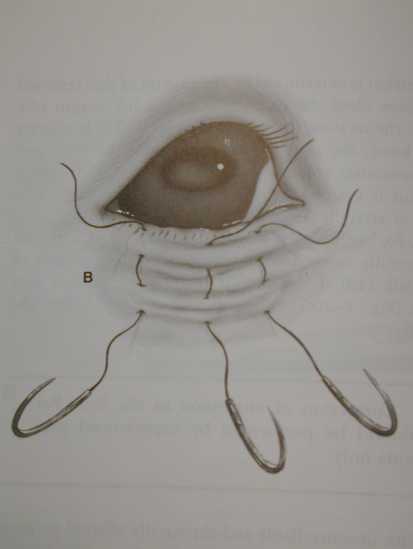
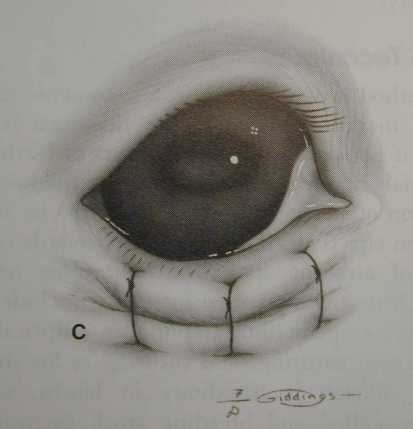
Placing and
knoding of temporarely stitches
(pictures Slatter).
Everted Third Eyelid
**************************
Occasionally, the third eyelid in dogs will fold over on itself, causing an
eversion. Great Danes, Golden Retrievers, and Saint Bernards appear to have
inherited traits for this condition, however, all breeds can be affected. The
third eyelid contains a cartilage support structure that may be defective or
injured, thus allowing the folding to occur. When this happens, the entire third
eyelid will actually appear folded forward over on itself. Occasionally, the
cornea can become irritated and an eye discharge may then be apparent.
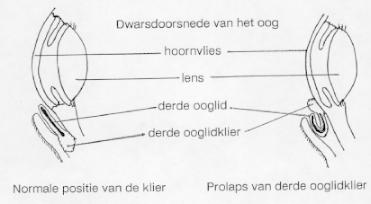
What are the risks?
An
everted third eyelid poses no great threat to health, except in rare instances
where corneal irritation or infection develops. For both cosmetic and health
reasons, most veterinarians recommend correction.
What is the management?
Eversion is corrected by surgery. The defective cartilage within the third
eyelid is dissected and removed, allowing the lid to unfold and return to its
normal position.
----------------------------------------------------------------------------------------
The cherry eye :
The
medical term for 'cherry eye' is nictitans gland prolapse, or prolapse of the
gland of the third eyelid. Unlike people, dogs have a 'third eyelid' that
contains a tear gland and is located in the corner of each eye. Under normal
circumstances, this gland is not visible and aids in the production of tears.
For some reason, which is not completely understood, the gland of the third
eyelid prolapses or comes out of its normal position and swells creating the
condition known as cherry eye.
 cherry eye with a
pekinees
cherry eye with a
pekinees
What dogs are likely
to get cherry eye?
Any dog can develop cherry eye, but there are several breeds that appear to
have a higher incidence of developing it in both eyes. They are: the Beagle,
Bloodhound, Boston Terrier, Bulldog, Bull Terrier, Lhasa Apso, Saint Bernard,
and Shar-Pei. Dogs can acquire this condition at any age and it affects males
and females equally.
What causes it?
The exact cause of cherry eye is not known, but it is strongly suspected that
it is due to a weakness of the connective tissue that attaches the gland to
the surrounding structures of the eye. The weakness of the connective tissue
allows the gland to prolapse. Once the gland prolapses and is exposed to the
dry air and irritants, it can become infected and/or begin to swell. The gland
often becomes irritated, red, and swollen. There is sometimes a mucous
discharge and if the animals rub or scratch at it, they can traumatize the
gland further or possibly create an ulcer on the surface of the eye.
What is the treatment?
Treatment of cherry eye is very straightforward and consists of surgically
repositioning the gland. Topical or injectable treatments of antibiotics and
steroids are rarely effective in reducing the gland and allowing for
correction without surgery. Because the exposed gland is at greater risk for
further trauma or infection, prompt surgical replacement is the best choice.
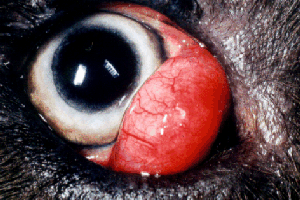
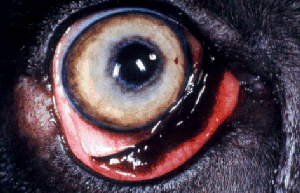
before and
after surgery of a mastino napolitano.
At one time, it was popular to surgically remove the gland as a way to correct
this condition. While this procedure is often effective, it can create many
problems later in the animals life. The gland of the third eyelid is very
important for the production of tears. Without the tears produced by the third
eyelid many dogs could suffer from the condition known as 'dry eye.' Dry eye
or keratoconjunctivitis sicca (KCS) is a serious condition that results from
the decreased production of tears. When the third eyelid gland is removed, we
are greatly increasing the chances for the development of this condition. The
much better and preferred surgical option is to surgically tack the gland back
into place with a suture that attaches the gland to the deeper structures of
the eye socket. Most of these surgeries are performed quickly and have very
few complications, and allow the gland to return to normal function. After the
surgery, some animals may need to be placed on antibiotic ointment for a few
days.
Hipdisplasie ectropion/entropion/prolaps
lupus
hotspot
worms
dangerous
foods panosteitis
bladderstones
cushing
FEMALES ----------------------------------------------------------------------------------------------------------------------------------
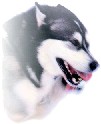



















MALES
--------------------------------------------------------------------------------------------------------------------------------------






PASSED AWAY :
-------------------------------------------------------------------------------------------------------------------------
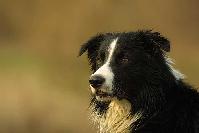



















----------------------------------------------------------------------------------------------------------------------------------------------------

















----------------------------------------------------------------------------------------------------------------------------------------------------